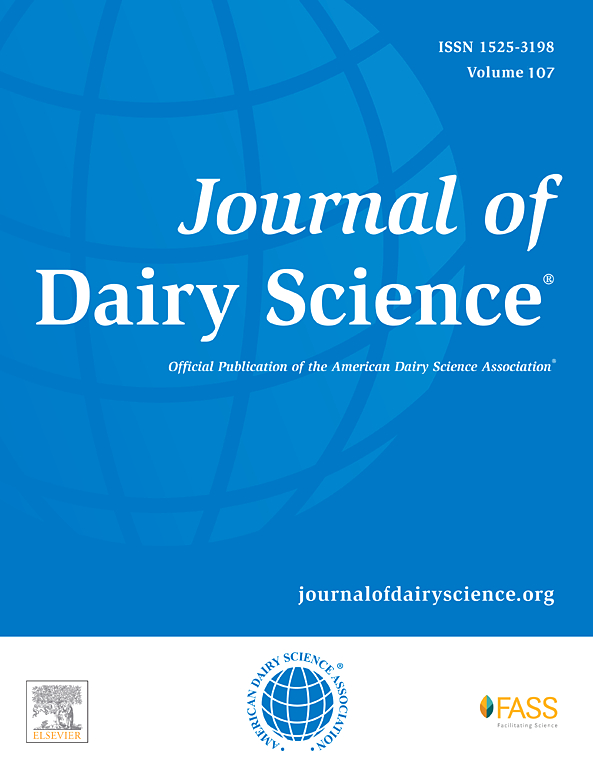单剂量瘤胃输注高或低浓度短链脂肪酸以及高或低pH值对断奶前乳牛表观总消化率和后肠发酵的影响
IF 4.4
1区 农林科学
Q1 AGRICULTURE, DAIRY & ANIMAL SCIENCE
引用次数: 0
摘要
pH值和短链脂肪酸(SCFA)对瘤胃发育的重要性众所周知,但它们对小肠和大肠的影响尚不清楚。本研究调查了高或低短链脂肪酸浓度和高或低pH值的单剂量瘤胃灌注如何影响犊牛的生产性能,以及在49天内3个时间点与后肠酸中毒相关的生理参数。单独饲养荷斯坦公牛犊牛(n = 32),每天喂两次代乳品(900 g/d),并自由饮用犊牛开食料和水。出生后第 10 ± 3 天,对瘤胃进行造瘘和插管。出生后第 14 天,按体重将犊牛分组,并按 2 × 2 的因子排列分配处理:高或低 SCFA 浓度(285 与 10 mM)和高或低 pH 值(6.2 与 5.2),形成 4 个处理组:高 SCFA 浓度、高 pH 值 (HS-HP);高 SCFA 浓度、低 pH 值 (HS-LP);低 SCFA 浓度、高 pH 值 (LS-HP) 和低 SCFA 浓度、低 pH 值 (LS-LP)。第 21、35 和 49 天,对粪便进行取样,以计算表观总消化率、确定有机酸浓度(即 SCFA、BCFA 和乳酸)和 pH 值。然后,排空瘤胃,用 4 种处理缓冲液中的一种进行单剂量灌胃 4 小时。第 49 天瘤胃输液结束后,收获犊牛,记录瘤胃、盲肠、结肠和直肠的组织重量、长度和消化液 pH 值,以及解剖后第 49 天十二指肠、空肠和回肠的消化液 pH 值。数据分析采用主因子作为固定效应,每周测量采用重复测量。各处理对采食量、ADG、表观总消化率和肠道测量等性能参数没有影响。在十二指肠、空肠和回肠,HS-HP 的消化液 pH 值高于 LS-HP,而后肠消化液 pH 值仅受 SCFA 浓度的影响。高浓度的SCFA增加了结肠异戊酸和粪便BCFA的浓度,而只有结肠乙酸和粪便乳酸的浓度受处理的影响。粪便中 SCFA 和 BCFA 的浓度主要在第 35 天增加。总之,在瘤胃中注入 4 小时生理缓冲液不会改变表观总消化率和肠道测量值,但会影响后肠发酵参数(即有机酸浓度和消化液 pH 值)。此外,犊牛出生后 35 d 左右发生后肠酸中毒的风险会增加。本文章由计算机程序翻译,如有差异,请以英文原文为准。
Effects of single-dose ruminal infusions of high or low short-chain fatty acid concentrations and high or low pH on apparent total-tract digestibility and hindgut fermentation of preweaning dairy calves
Although the importance of pH and short-chain fatty acids (SCFA) on rumen development are well-known, their impact on the small and large intestine are unclear. This study investigated how single-dose ruminal infusions with high or low SCFA concentrations and high or low pH affect calves' productivity, as well as physiological parameters associated with hindgut acidosis at 3 time points in 49 d. Holstein bull calves (n = 32) were individually housed and fed milk replacer (900 g/d) twice daily and calf starter and water ad libitum. At d 10 ± 3 of life, the rumens were fistulated and cannulated. At d 14 of life, calves were grouped by BW and assigned in a 2 × 2 factorial arrangement of treatments: high or low SCFA concentration (285 vs. 10 mM) and high or low pH (6.2 vs. 5.2), creating 4 treatment groups: high SCFA concentration, high pH (HS-HP); high SCFA concentration, low pH (HS-LP); low SCFA concentration, high pH (LS-HP); and low SCFA concentration, low pH (LS-LP). On d 21, 35, 49, feces were sampled to calculate apparent total-tract digestibility, determinate organic acid concentrations (i.e., SCFA, branched-chain fatty acid [BCFA], and lactic acid), and pH. Afterward, the rumen was evacuated and underwent a single-dose infusion for 4 h with 1 of 4 treatment buffers. After completion of rumen infusion on d 49, calves were killed and the tissue weight and length were recorded, along with the digesta pH of the rumen, duodenum, jejunum, ileum, cecum, colon, and rectum. Data were analyzed with main factors as fixed effects and repeated measures for weekly measurements. Treatments did not affect performance parameters such as feed intake, ADG, apparent total-tract digestibility and gut measurements. In the duodenum, jejunum, and ileum, HS-HP had a greater digesta pH than LS-HP, whereas the hindgut digesta pH was only affected by the SCFA concentration. A high SCFA concentration increased the concentration of colonic isovaleric acid and fecal BCFA, whereas only colonic acetic acid and fecal lactic acid concentrations were affected by treatment. Fecal SCFA and BCFA concentrations increased mainly on d 35. In summary, 4 h of physiological buffer infusion in the rumen does not change apparent total-tract digestibility and gut measurements but does affect hindgut fermentation parameters (i.e., organic acid concentrations and digesta pH). In addition, calves can experience increased risks of hindgut acidosis around 35 d of life.
求助全文
通过发布文献求助,成功后即可免费获取论文全文。
去求助
来源期刊

Journal of Dairy Science
农林科学-奶制品与动物科学
CiteScore
7.90
自引率
17.10%
发文量
784
审稿时长
4.2 months
期刊介绍:
The official journal of the American Dairy Science Association®, Journal of Dairy Science® (JDS) is the leading peer-reviewed general dairy research journal in the world. JDS readers represent education, industry, and government agencies in more than 70 countries with interests in biochemistry, breeding, economics, engineering, environment, food science, genetics, microbiology, nutrition, pathology, physiology, processing, public health, quality assurance, and sanitation.
 求助内容:
求助内容: 应助结果提醒方式:
应助结果提醒方式:


